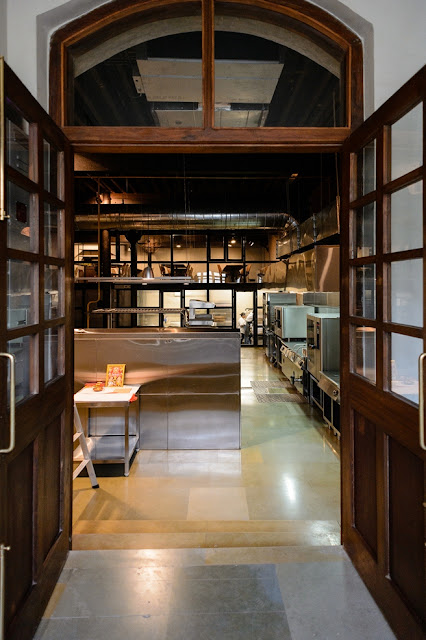Getting to know Japanese Cuisine
I have been intrigued by the name of Magazine Street Kitchen,ever since I read about it.Turns out Magazine Street is the street in Byculla it is on.
The Kitchen is beautiful and spacious,2500 sq feet to be precise! Something one finds hard to find in Mumbai.We were seated above in the dining area as we waited for everyone to arrive.This is where top chefs from around the world serve their fare.Their bakery sends its goods to the weekend sale at Colaba and Bandra
Ten of us gathered to learn about Japanese cuisine,beyond sushi.Some of the people in our group had already visited Japan and though Chef Divesh Aswani hadn't,it didn't stop him from taking us on an interesting journey of making Gyozas,Tempura,Teriyaki and Ramen.
We discovered a world of new ingredients: Seaweed,Shitake Mushrooms,Bonito (Tuna) Flakes,Soy,Yuzu and Sake.Both seaweed and shitake mushrooms are a good source of glutamic acid,as Chef Divesh enlightened us.Glutamic acid is important for brain development and function.Shitake mushrooms incidentally are also the only vegetarian source of Vitamin D.One sees so many people with Vitamin D deficiency these days.Seaweed is a vegetarian source of the much required long chain omega 3 fatty acids.
We were divided into groups,with vegetarians making their version.Chef Divesh was the master of the ship and a sous chef helped each group with techniques while Chef Divesh came to each table to teach.We were given handouts to follow.Each group made all the dishes with team members dividing tasks like cutting vegetables,cleaning prawns etc
We were on our feet from beginning to end but had a snack of tempura and gyozas as we cooked.We were surrounded by fresh produce and state of art equipment
Gyozas originated in China and were first made by a Chinese physician to treat patients with frostbitten ears thus the name.They do look like them.Japanese Gyozas are thinner than their Chinese counterparts.Traditionally made with pork,chives,onions,cabbage,ginger and garlic,ours were of chicken (non vegetarian) and shitake-asparagus (vegetarian).Turned out absolutely scrumptious! We made a dipping sauce and yuzu mayonnaise.
Making mayonnaise is an art.You learn to focus on just one thing,else the whole thing goes for a toss.Yuzu adds the citrus kick
There were several among us who had come mainly to learn how to make Ramen (noodle soup dish).I sheepishly have to admit that the only Ramen I have had in the past has been from cuppa soup packets and I haven't liked it much.What we made,made me realize why Yokohama has its own Ramen Museum!
We first made a broth and then each group had their own topping.Ours was seaweed,browned onions and roast pork belly.It was superb! No wonder there's a museum in its honor!
Teriyaki involves a glaze of sugar,mirin and soy sauce.We did a Seabass Teriyaki which was astounding! Every bite took you to heaven! While making the sauce,one needs to remember that soy sauce is a source of salt and one has to adjust accordingly.The vegetarians made Eggplant Teriyaki which was excellent as well.
Mushrooms are a good source of protein and fibre.We used Enoki as well.Made Tempura.Though deep-fried,it has a thin batter due to which it does not absorb much oil.
Enoki (or golden needle mushroom) tempuras make a pretty picture and research shows they have a beneficial effect on the immune system and have been studied for cancer prevention.Also called the Winter Fungus as found in winter.
We also made some with prawns,broccoli,eggplant and pumpkin.These days,everyone is careful about fried food but this is for the occasional treat.Tempuras came to the Japanese from the Portuguese.My school friend Sonal who lives in Japan talked of the bento boxes that Japanese mothers got up early in the morning to prepare for school children.The box had colorful characters and a balance of items,carefully prepared and presented.One of the items was tempura.Sonal mentioned that there were vegan sushi restaurants in Tokyo.Vegetarians have to only enquire about dashi or bonito flakes being added.
As Kumar and Geeta Jhuremalani are just back from Japan,I asked them about their food experiences.Kumar runs a group called Pet Pujaris that meets every month at a Fatka place (pricey restaurant) or a Kadka place (street food usually).They are on Instagram too as "petpujaris"
Their favorite meal was a Set Lunch menu at Milkland in Tokyo,filled with tofu and vegetables,mostly known,some unknown :D They are vegetarians but with preplanning,they had no difficulty in finding good vegetarian food.
"The meals in Japan were all about balance and subtle tastes.Nothing overly aggressive on any one taste or sense",Kumar remarked.Japanese cuisine (Washoku) is one of the three cuisines recognized by the United Nations for its cultural significance.
In Kyoto,they went to a zen restaurant Shigetsu in Tenryu-ji Temple.Everyone sat on tatami mats and had their meal with chopsticks.Except for the orange clad holy Indian man (who was visiting) who ate with his hands...
Leave you with this pictures of Indian fans of Matcha (green tea powder).Go green just got a new meaning!!























Comments